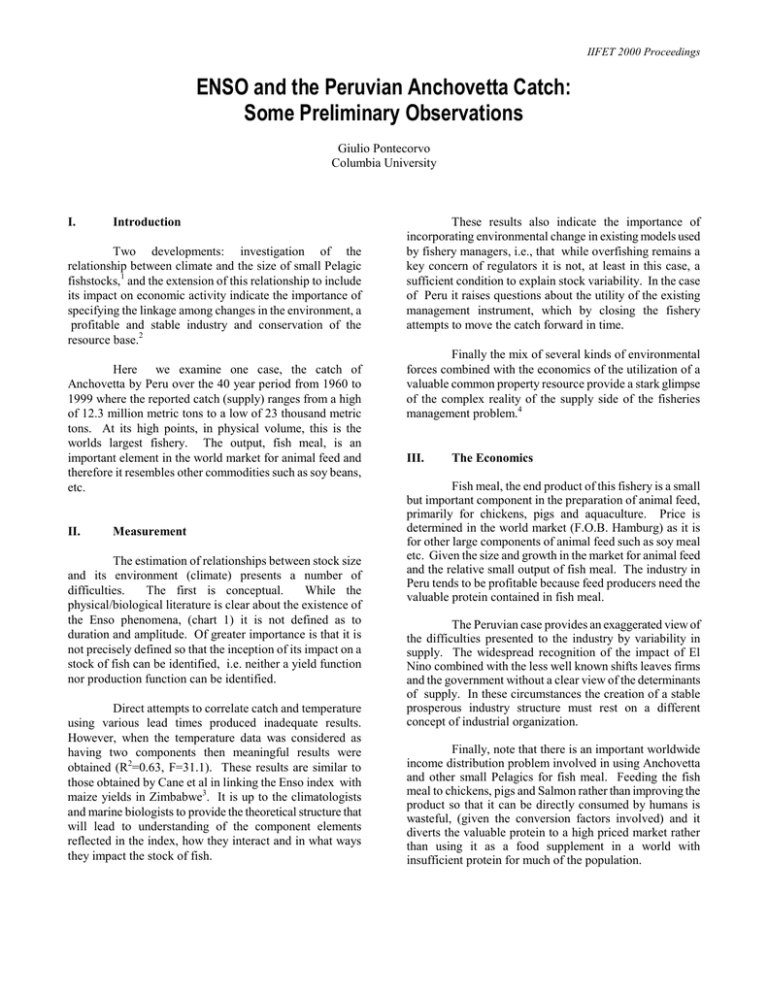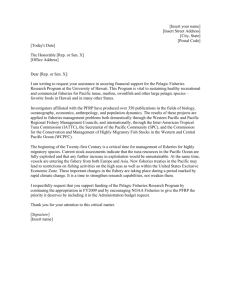ENSO and the Peruvian Anchovetta Catch: Some Preliminary Observations
advertisement

IIFET 2000 Proceedings ENSO and the Peruvian Anchovetta Catch: Some Preliminary Observations Giulio Pontecorvo Columbia University I. Introduction Two developments: investigation of the relationship between climate and the size of small Pelagic fishstocks,1 and the extension of this relationship to include its impact on economic activity indicate the importance of specifying the linkage among changes in the environment, a profitable and stable industry and conservation of the resource base.2 Here we examine one case, the catch of Anchovetta by Peru over the 40 year period from 1960 to 1999 where the reported catch (supply) ranges from a high of 12.3 million metric tons to a low of 23 thousand metric tons. At its high points, in physical volume, this is the worlds largest fishery. The output, fish meal, is an important element in the world market for animal feed and therefore it resembles other commodities such as soy beans, etc. II. Measurement The estimation of relationships between stock size and its environment (climate) presents a number of difficulties. The first is conceptual. While the physical/biological literature is clear about the existence of the Enso phenomena, (chart 1) it is not defined as to duration and amplitude. Of greater importance is that it is not precisely defined so that the inception of its impact on a stock of fish can be identified, i.e. neither a yield function nor production function can be identified. Direct attempts to correlate catch and temperature using various lead times produced inadequate results. However, when the temperature data was considered as having two components then meaningful results were obtained (R2=0.63, F=31.1). These results are similar to those obtained by Cane et al in linking the Enso index with maize yields in Zimbabwe3. It is up to the climatologists and marine biologists to provide the theoretical structure that will lead to understanding of the component elements reflected in the index, how they interact and in what ways they impact the stock of fish. These results also indicate the importance of incorporating environmental change in existing models used by fishery managers, i.e., that while overfishing remains a key concern of regulators it is not, at least in this case, a sufficient condition to explain stock variability. In the case of Peru it raises questions about the utility of the existing management instrument, which by closing the fishery attempts to move the catch forward in time. Finally the mix of several kinds of environmental forces combined with the economics of the utilization of a valuable common property resource provide a stark glimpse of the complex reality of the supply side of the fisheries management problem.4 III. The Economics Fish meal, the end product of this fishery is a small but important component in the preparation of animal feed, primarily for chickens, pigs and aquaculture. Price is determined in the world market (F.O.B. Hamburg) as it is for other large components of animal feed such as soy meal etc. Given the size and growth in the market for animal feed and the relative small output of fish meal. The industry in Peru tends to be profitable because feed producers need the valuable protein contained in fish meal. The Peruvian case provides an exaggerated view of the difficulties presented to the industry by variability in supply. The widespread recognition of the impact of El Nino combined with the less well known shifts leaves firms and the government without a clear view of the determinants of supply. In these circumstances the creation of a stable prosperous industry structure must rest on a different concept of industrial organization. Finally, note that there is an important worldwide income distribution problem involved in using Anchovetta and other small Pelagics for fish meal. Feeding the fish meal to chickens, pigs and Salmon rather than improving the product so that it can be directly consumed by humans is wasteful, (given the conversion factors involved) and it diverts the valuable protein to a high priced market rather than using it as a food supplement in a world with insufficient protein for much of the population. IIFET 2000 Proceedings References 1. 3. Forecasting Zimbabwean Maize yields using Eastern equatorial pacific Sea surface temperature. M. Cane, G. Eshel, & R.W. Buckland, Nature, vol. 370, 21, July 1994. Scaling Fisheries Tim P. Smith Cambridge University Press 1994, page 1. 4. Lluch-Cota op. cit; also A. Bakum “A Focus on Small Pelagic Fisheries” F.A.O. Documents; A. Bakum, “New Concept for Understanding Variability in Small Pelagic Fisheries”, F.A.O. Casablanca 1996; J.H. Steele, “Regime Shifts in Marine Ecosystems” Ecological Applications, September 1998. Empirical investigation on the relationship between climate and small Pelagic global regimes and El Nino - Southern occilation (Enso), F.A.O. Fisheries circular No. 934 D.B. Lluch-Cota, S. Hernandez Vazquez & S.E. Lluch-Cota Rome, November 1997. 2. Forecasting Zimbabwean Maize yields using Eastern equatorial pacific Sea surface temperature. M. Cane, G. Eshel, & R.W. Buckland, Nature, vol. 370, 21, July 1994. 3. Lluch-Cota op. cit; also A. Bakum “A Focus on Small Pelagic Fisheries” F.A.O. Documents; A. Bakum, “New Concept for Understanding Variability in Small Pelagic Fisheries”, F.A.O. Casablanca 1996; J.H. Steele, “Regime Shifts in Marine Ecosystems” Ecological Applications, September 1998. 4. Colin Clark: “Fishery Systems Are Much Too Complex, Biologically, Socially and Economically, for there to exist any simple solution to the problem of fisheries management”. “Bioeconomic Modelling and Fisheries Management”, 1991, John Wiley & Sons, Inc. P.10. 5 Kawasaki, Tsuyoshi “Global warming could have a tremendous effect on the world fisheries production”. Paper presented at the IIFET Conference , Corvallis, Oregon, July 2000. Endnotes 1. Acknowledgments: I wish to thank John Marra, Columbia, Mark Cane, Columbia, Stephen Zebiak, IRI/Columbia, William Schrank, Memorial, Canada, Ron Schramm, Columbia, for helpful comments, and Delores Brown and Andreas Alvarez for their assistance in preparation of the manuscript. 2. Empirical investigation on the relationship between climate and small Pelagic global regimes and El Nino Southern occilation (Enso), F.A.O. Fisheries circular No. 934 D.B. Lluch-Cota, S. Hernandez Vazquez & S.E. Lluch-Cota Rome, November 1997. 2




